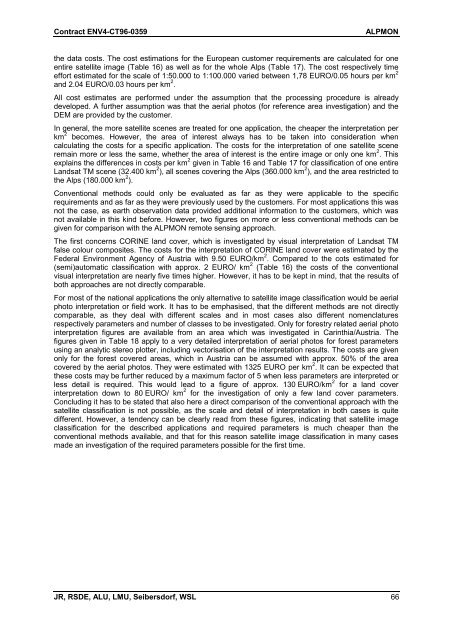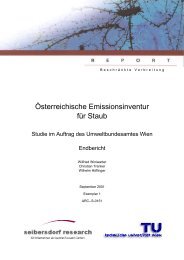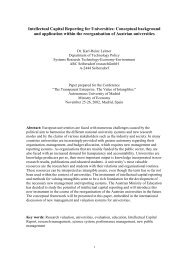ALPMON FINAL REPORT - ARC systems research
ALPMON FINAL REPORT - ARC systems research
ALPMON FINAL REPORT - ARC systems research
You also want an ePaper? Increase the reach of your titles
YUMPU automatically turns print PDFs into web optimized ePapers that Google loves.
Contract ENV4-CT96-0359 <strong>ALPMON</strong><br />
the data costs. The cost estimations for the European customer requirements are calculated for one<br />
entire satellite image (Table 16) as well as for the whole Alps (Table 17). The cost respectively time<br />
effort estimated for the scale of 1:50.000 to 1:100.000 varied between 1,78 EURO/0.05 hours per km 2<br />
and 2.04 EURO/0.03 hours per km 2 .<br />
All cost estimates are performed under the assumption that the processing procedure is already<br />
developed. A further assumption was that the aerial photos (for reference area investigation) and the<br />
DEM are provided by the customer.<br />
In general, the more satellite scenes are treated for one application, the cheaper the interpretation per<br />
km 2 becomes. However, the area of interest always has to be taken into consideration when<br />
calculating the costs for a specific application. The costs for the interpretation of one satellite scene<br />
remain more or less the same, whether the area of interest is the entire image or only one km 2 . This<br />
explains the differences in costs per km 2 given in Table 16 and Table 17 for classification of one entire<br />
Landsat TM scene (32.400 km 2 ), all scenes covering the Alps (360.000 km 2 ), and the area restricted to<br />
the Alps (180.000 km 2 ).<br />
Conventional methods could only be evaluated as far as they were applicable to the specific<br />
requirements and as far as they were previously used by the customers. For most applications this was<br />
not the case, as earth observation data provided additional information to the customers, which was<br />
not available in this kind before. However, two figures on more or less conventional methods can be<br />
given for comparison with the <strong>ALPMON</strong> remote sensing approach.<br />
The first concerns CORINE land cover, which is investigated by visual interpretation of Landsat TM<br />
false colour composites. The costs for the interpretation of CORINE land cover were estimated by the<br />
Federal Environment Agency of Austria with 9.50 EURO/km 2 . Compared to the cots estimated for<br />
(semi)automatic classification with approx. 2 EURO/ km 2 (Table 16) the costs of the conventional<br />
visual interpretation are nearly five times higher. However, it has to be kept in mind, that the results of<br />
both approaches are not directly comparable.<br />
For most of the national applications the only alternative to satellite image classification would be aerial<br />
photo interpretation or field work. It has to be emphasised, that the different methods are not directly<br />
comparable, as they deal with different scales and in most cases also different nomenclatures<br />
respectively parameters and number of classes to be investigated. Only for forestry related aerial photo<br />
interpretation figures are available from an area which was investigated in Carinthia/Austria. The<br />
figures given in Table 18 apply to a very detailed interpretation of aerial photos for forest parameters<br />
using an analytic stereo plotter, including vectorisation of the interpretation results. The costs are given<br />
only for the forest covered areas, which in Austria can be assumed with approx. 50% of the area<br />
covered by the aerial photos. They were estimated with 1325 EURO per km 2 . It can be expected that<br />
these costs may be further reduced by a maximum factor of 5 when less parameters are interpreted or<br />
less detail is required. This would lead to a figure of approx. 130 EURO/km 2 for a land cover<br />
interpretation down to 80 EURO/ km 2 for the investigation of only a few land cover parameters.<br />
Concluding it has to be stated that also here a direct comparison of the conventional approach with the<br />
satellite classification is not possible, as the scale and detail of interpretation in both cases is quite<br />
different. However, a tendency can be clearly read from these figures, indicating that satellite image<br />
classification for the described applications and required parameters is much cheaper than the<br />
conventional methods available, and that for this reason satellite image classification in many cases<br />
made an investigation of the required parameters possible for the first time.<br />
JR, RSDE, ALU, LMU, Seibersdorf, WSL 66




